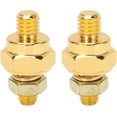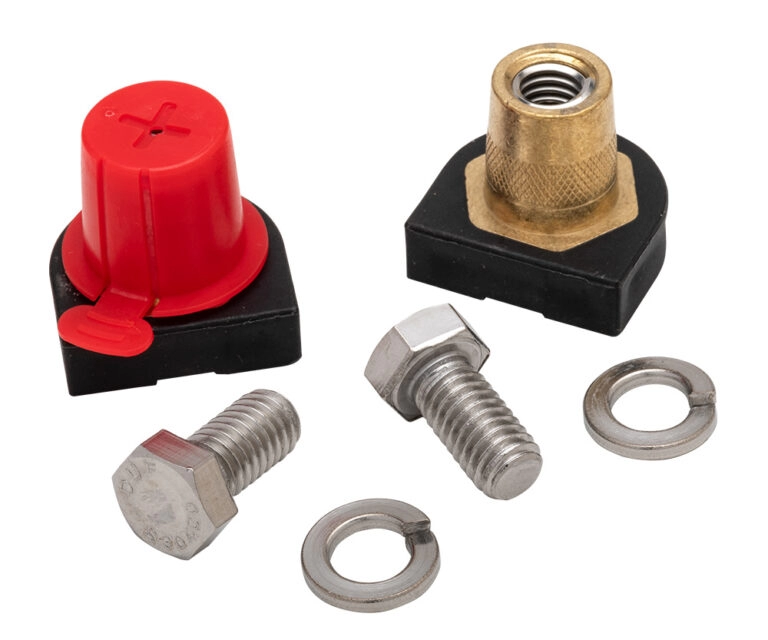Battery terminal adapters are crucial components that ensure a reliable and secure connection between a battery and an electrical system. They come in various types, such as top post, side post, and stud adapters, designed for different applications in vehicles, marine systems, and equipment. In this guide, we’ll cover the different types of battery terminal adapters, their uses, installation tips, and maintenance advice. Whether you’re a professional or a DIY enthusiast, this guide will provide helpful insights. This guide provides comprehensive and easy-to-understand information.
Part 1: What are Battery Terminal Adapters?
Battery terminal adapters help establish a connection between the battery terminals and the cables or connectors in a vehicle or device. They come in different shapes and sizes to accommodate various battery terminals and connectors, ensuring the reliability and safety of the electrical connection.

Why are Battery Terminal Adapters Important?
Battery terminal adapters serve several key purposes:
- Versatility: They allow different connectors to be used with a single battery.
- Safety: By ensuring a secure connection, they minimize the risk of loose connections leading to electrical faults or fires.
- Convenience: They simplify the process of connecting and disconnecting batteries, especially in tight spaces.
Part 2: Types of Battery Terminal Adapters
To understand the different types of battery terminal adapters, you must first understand the different battery terminal styles and how these adapters interact with them.
Battery terminals are the points where current enters or exits a battery, and they come in several designs, primarily:
- Top Post (SAE Post)
- Side Post
- Stud Terminal
- L-shaped Terminal
- Button Terminal (commonly found in motorcycle batteries)
Battery terminal adapters modify or extend these terminals to allow compatibility with various connectors and improve the quality of the connection. They effectively bridge the gap between the battery’s original terminal and the connection needed for your specific use case.
Let’s explore the types of battery terminal adapters in detail:
1. Top Post (SAE Post) Adapters
Top post adapters are the most common and are designed for batteries with standard top post terminals.
- Polarity Converters: These adapters allow you to switch the positive and negative terminals, which can be particularly useful when replacing a battery with reversed polarity.
- Post Shims: Thin, conductive plates that fit over the posts to increase their diameter, ensuring a secure fit for larger cable ends.
- Post to Stud Adapters: These adapters convert a top post battery to accept stud-style connections.
2. Side Post Adapters
Side post adapters are designed for batteries with side-mounted terminals and come in several types.
- Side Post to Top Post Adapters: These adapters allow you to use a side post battery in a vehicle that requires a top post battery, often due to space constraints.
- Side Post Extenders: These adapters provide additional connection points for accessories or multiple cables.
3. Stud Adapters
Stud adapters are used with batteries that have threaded stud terminals.
- Stud to Post Adapters: These adapters allow the use of a stud battery in applications designed for top post batteries.
- Stud Extenders: These adapters extend the stud, facilitating connections in tight spaces.
4. Marine Battery Terminal Adapters
These adapters are specifically designed for marine applications and offer enhanced corrosion resistance.
- Wing Nut Adapters: These adapters provide easy-to-use connection points that can be tightened by hand, ideal for marine environments due to their corrosion resistance.
- Multi-Port Adapters: These adapters offer multiple connection points to accommodate the many accessories common in marine systems.
5. Universal Adapters
Universal adapters are designed to fit a variety of terminal types, providing flexibility in different setups.
- Clamp-On Adapters: These adapters accommodate various terminal types and convert them to standard post or stud connections.
- Multi-Function Adapters: These versatile adapters feature multiple connection options in one unit, offering excellent flexibility for various applications.
With this guide, you now have a clear understanding of the different types of battery terminal adapters and how they can improve the reliability and safety of your battery connections. Whether you’re working on a vehicle, marine system, or device, these adapters are essential for ensuring a reliable and secure connection.
For those interested in marine battery systems, you can read more about marine battery types and their specific uses.
Battery Terminal Adapters: A Comprehensive Guide
Battery terminal adapters are essential in various applications, such as automotive and marine equipment, for establishing a secure and efficient connection between a battery and an electrical system. In this guide, we’ll cover the different types of adapters, how to choose the right one, installation tips, and maintenance advice.
Types of Battery Terminal Adapters
1. Standard Battery Terminal Adapters
These adapters are designed to fit standard battery terminals and come in several forms, including:
- Top Post Adapters: Designed for batteries with top-mounted terminals, commonly found in most vehicles.
- Side Post Adapters: These are used for batteries with side-mounted terminals, common in some cars and trucks.
- Stud Adapters: These adapters provide a connection for batteries with stud-type terminals, often found in commercial or heavy-duty applications.
2. Specialized Battery Terminal Adapters
a) Marine-Grade Adapters
Marine-grade adapters are specifically designed to withstand harsh environments such as saltwater, ensuring reliable connections for boats and marine equipment.
b) Heavy-Duty Adapters
These adapters are designed for high-power applications, ensuring a durable and secure connection under heavy loads.
c) Quick-Disconnect Adapters
Quick-disconnect adapters allow for easy connection and disconnection of batteries, especially useful in scenarios requiring frequent battery changes.
- Military-Grade Quick Disconnects: Originally designed for military vehicles, offering a secure, waterproof, and quickly releasable connection.
- NATO Standard Adapters: These adapters are common in military and heavy-duty applications, ensuring compatibility across different systems.
d) Smart Battery Terminal Adapters
Smart adapters come with advanced monitoring and protection features:
- Fused Adapters: These adapters include built-in fuses, providing additional protection against electrical faults.
- Battery Management Adapters: Some adapters offer features like voltage monitoring, cutoff switches, and even Bluetooth connectivity for remote monitoring.
Key Takeaways About Battery Terminal Adapters
- Battery terminal adapters ensure a secure and reliable connection between a battery and an electrical system.
- There are various types, including top post, side post, and stud adapters, each designed for specific applications.
- Choosing the right adapter depends on your battery type, application, and environment, such as marine or automotive use.
How to Choose the Right Battery Terminal Adapter
When selecting a battery terminal adapter, consider the following factors:
- Compatibility: Ensure the adapter matches the terminal type of your battery (e.g., top post, side post, stud).
- Material Quality: Opt for high-quality materials like brass or copper for better conductivity and durability.
- Application: Ensure the adapter is suitable for your specific needs, whether it’s for marine, automotive, or DIY projects.
Tips for Buying Battery Terminal Adapters
When buying battery terminal adapters, keep these tips in mind:
- Quality: Choose high-quality adapters made from durable materials like brass or copper for long-lasting performance.
- Compatibility: Verify that the adapter fits correctly on your battery terminals and connectors.
- User Reviews: Check reviews and ratings from other users to ensure the adapter’s reliability and performance.
- Warranty: Look for adapters with a warranty for greater confidence.
How to Install Battery Terminal Adapters: A Step-by-Step Guide
Installing battery terminal adapters is a straightforward process, but it’s essential to follow the correct steps to ensure safety and efficiency:
- Disconnect the Battery: Always disconnect the negative terminal first to avoid any risk of short circuits.
- Clean the Terminals: Use a wire brush to remove any corrosion from the battery terminals.
- Install the Adapter: Place the adapter on the battery terminal and secure it using the appropriate hardware.
- Reconnect the Cables: Connect the cables to the adapter, ensuring they are tightly secured.
- Reconnect the Battery Terminals: Reconnect the positive terminal first, followed by the negative terminal. This order is important to prevent electrical arcing and potential damage to your vehicle’s electrical system.
Maintenance Tips for Battery Terminal Adapters
Proper maintenance can extend the lifespan of your battery terminal adapters and ensure their continued performance:
- Regular Inspections: Frequently check for any signs of wear, corrosion, or damage.
- Clean the Terminals: Regularly clean the terminals and adapters with a wire brush or battery cleaner.
- Ensure Tight Connections: Ensure the connections are tight to prevent loosening over time.
- Replace Damaged Adapters: If any adapters show signs of wear or damage, replace them immediately to maintain a secure connection.
Common Issues with Battery Terminal Adapters and How to Solve Them
Battery terminal adapters may encounter some issues over time, but most of them can be easily resolved:
- Corrosion: Clean the terminals and adapters with a mixture of baking soda and water to remove any corrosion.
- Loose Connections: Tighten any loose connections to ensure a secure and reliable connection.
- Worn Adapters: Replace worn or damaged adapters to avoid potential connection problems.
Whether you’re working on automotive, marine, or DIY projects, choosing the right adapter for your needs is crucial for long-term performance and safety.

All About Battery Terminal Adapters
Battery terminal adapters are essential components designed to establish a secure connection between battery terminals and cables or connectors, ensuring a reliable electrical current flow. In this article, we will explore the function, selection, and maintenance of battery terminal adapters.
What is the Purpose of a Battery Terminal Adapter?
The role of a battery terminal adapter is to connect battery terminals to cables and connectors, ensuring a secure and stable electrical connection.
Can I Use Just Any Battery Terminal Adapter with My Battery?
No, it’s important to select an adapter that is compatible with the type of battery terminal you have (e.g., top-post, side-post) and the specific connectors you plan to use.
How Do I Know If My Battery Terminal Adapter Needs to Be Replaced?
You should replace your battery terminal adapter if any of the following occur:
- Visible wear, tear, or damage.
- Corrosion that cannot be cleaned.
- Loose connections that cannot be properly tightened.
Are There Specific Adapters for Marine Batteries?
Yes, marine battery terminal adapters are corrosion-resistant and are specifically engineered for marine environments, maintaining reliable connections in challenging conditions.
How Often Should I Inspect and Clean My Battery Terminal Adapters?
Inspect and clean your battery terminal adapters at least every three months, and more often if you notice any issues such as corrosion or loose connections.
Related Articles:
Here are some related articles for your reference:
- Easy Guide: Choosing the Right Battery for Your Garden Tractor
Not sure which battery to choose for your garden tractor? We’ve got you covered with expert tips to help you select the right battery for your needs. - Understanding Deep Cycle Battery Charging
Charging deep cycle batteries doesn’t have to be confusing. Our guide explains the best practices for safely and effectively charging these batteries. - Battery Array vs. Single Battery: Which is Better for Your Energy Needs?
Wondering whether to use a battery array or a single battery? Learn about the pros and cons of each approach to help you make an informed decision. - What is a Battery Array?
A battery array is a group of connected batteries that ensures a reliable power supply. Learn about the types, benefits, and applications of battery arrays. - Growth Trends in Flexible Thin Film and Printed Battery Markets
The flexible thin film and printed battery markets are rapidly evolving. Learn about the growth, innovations, and challenges shaping this exciting field.







